Modes of Reproduction
Section Goals
By the end of this section, you will be able to do the following:
- Compare and contrast asexual and sexual reproduction methods
- Describe the advantages and disadvantages of asexual and sexual reproduction
- Discuss external and internal methods of fertilization
The chapters of this text that highlight topics regarding reproduction and sex do not refer to gender, which is a different concept.
Although the terms are sometimes used interchangeably, sex and gender refer to two different ideas. According to the American Psychological Association: “Sex is typically assigned at birth (or before during ultrasound) based on the appearance of external genitalia. When the external genitalia is ambiguous, other indicators (e.g., internal genitalia, chromosomal and hormonal sex) are considered to assign a sex, with the aim of assigning a sex that is most likely to be congruent with the child’s gender identity.” Gender is “a person’s deeply felt, inherent sense of being a girl, woman, or female; a boy, a man, or male; a blend of male or female; or an alternative gender[1].”
Gender influences how people perceive themselves and each other, how they act and interact, and the distribution of power and resources in society. Gender identity is not confined to a binary (girl/woman, boy/man), nor is it static; it exists along a continuum and can change over time. There is considerable diversity in how individuals and groups understand, experience, and express gender through their roles, the expectations placed on them, their relations with others, and the complex ways that gender is institutionalized in society.
Just like there are many individuals for whom chromosomal, hormonal, gonadal, and anatomical sex do not align, so too are there individuals whose innate gender identity or gender expression differs from their phenotypic sex as determined by external genitalia. This situation is called transgender. Individuals for whom their gender identity is the same as their phenotypic sex are cisgender.
Historically, the biology of gender has not been as well studied as sex, and, as such, it is poorly understood. However, a number of studies provide strong evidence that gender is innate, with both genetic and other biological causes. For example, transgender individuals may have brain structures that more closely match their gender than their phenotypic sex. A majority of individuals with 5-alpha-reductase deficiency choose to live as male after puberty, despite culturally having been raised as female to that point. XY babies with abnormal genitalia who are surgically assigned a female sex (a practice more common in previous decades) have a much higher incidence of transgender. And twin studies and adoption studies – standard ways to determine whether genetic factors affect a trait – strongly suggest a genetic component to gender.
Sexual and Asexual Reproduction
Reproduction is the production of offspring. Reproduction can happen in a variety of ways and is usually separated into sexual and asexual reproduction. Both methods have advantages and disadvantages.
Asexual reproduction produces offspring that are genetically identical to the reproducing individual. Note that this is a different term from human asexual identity.
A single individual can produce offspring asexually, and large numbers of offspring can be produced quickly. In a stable or predictable environment, asexual reproduction is an effective means of reproduction because all the offspring will be adapted to that environment. In an unstable or unpredictable environment, asexually reproducing species may be at a disadvantage because all the offspring are genetically identical and may not have the genetic variation to survive in new or different conditions. On the other hand, the rapid rates of asexual reproduction may allow for a speedy response to environmental changes if individuals have mutations. An additional advantage of asexual reproduction is that colonization of new habitats may be easier when an individual does not need to find a mate to reproduce.
During sexual reproduction, the genetic material of two individuals is combined to produce genetically diverse offspring that differ from their parents. (Sexual reproduction involves meiosis, a cell division process that creates sex cells). The genetic diversity of sexually produced offspring is thought to give species a better chance of surviving in an unpredictable or changing environment. Species that reproduce sexually must maintain two different types of individuals, males, and females, which can limit the ability to colonize new habitats as both sexes must be present.
Try It!
Asexual Reproduction
Asexual reproduction occurs in prokaryotic microorganisms (bacteria) and some eukaryotic single-celled and multi-celled organisms. There are a number of ways that animals reproduce asexually.
Fission
Fission, also called binary fission, occurs in prokaryotic microorganisms and in some invertebrate, multi-celled organisms. After a period of growth, an organism splits into two separate organisms. Some unicellular eukaryotic organisms undergo binary fission by mitosis. In other organisms, part of the individual separates and forms a second individual. This process occurs, for example, in many asteroid echinoderms through the splitting of the central disk. Some sea anemones and some coral polyps (Figure 1) also reproduce through fission.
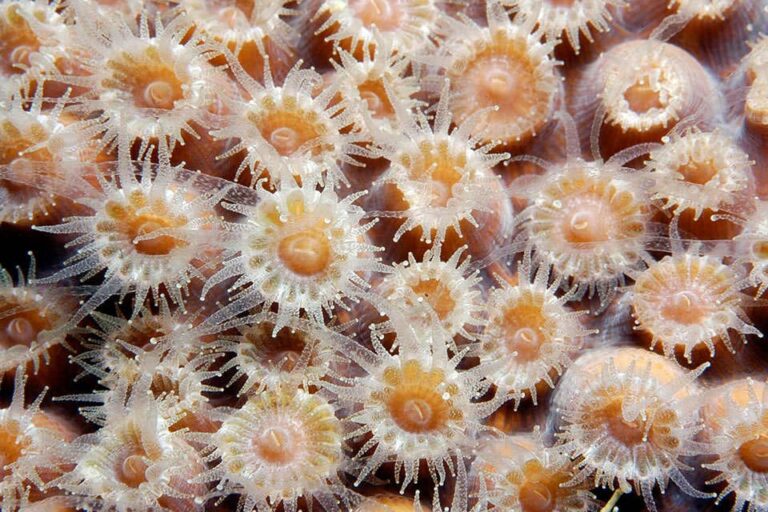
Budding
Budding is a form of asexual reproduction that results from the outgrowth of a part of a cell or body region leading to a separation from the original organism into two individuals. Budding occurs commonly in some invertebrate animals such as corals and hydras. In hydras, a bud forms that develops into an adult and breaks away from the main body, as illustrated in Figure 2, whereas in coral budding, the bud does not detach and multiplies as part of a new colony.
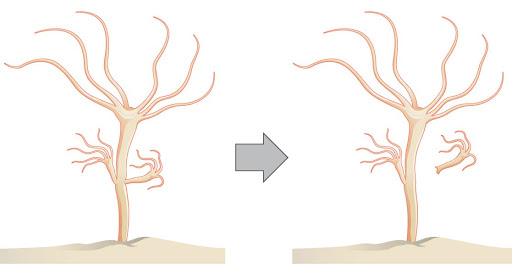
Watch this video of a hydra budding! Note that there is no audio in this video.
Fragmentation
Fragmentation is the breaking of the body into two parts with subsequent regeneration. If the animal is capable of fragmentation, and the part is big enough, a separate individual will regrow.
For example, in many sea stars, asexual reproduction is accomplished by fragmentation. Figure 3 illustrates a sea star for which an arm of the individual is broken off and regenerates a new sea star. Fisheries workers have been known to try to kill the sea stars eating their clam or oyster beds by cutting them in half and throwing them back into the ocean. Unfortunately for the workers, the two parts can each regenerate a new half, resulting in twice as many sea stars to prey upon the oysters and clams. Fragmentation also occurs in annelid worms, turbellarians, and poriferans.
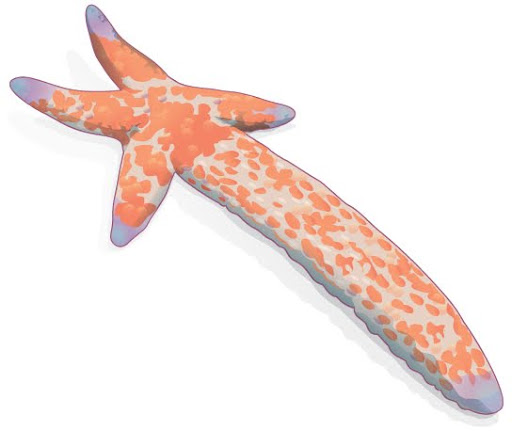
Note that in fragmentation, there is generally a noticeable difference in the size of the individuals, whereas in fission, two individuals of approximate size are formed.
Parthenogenesis
Parthenogenesis is a form of asexual reproduction where an egg develops into a complete individual without being fertilized. The resulting offspring can be either haploid or diploid, depending on the process and the species. Parthenogenesis occurs in invertebrates such as water fleas, rotifers, aphids, stick insects, some ants, wasps, and bees. Bees use parthenogenesis to produce haploid males (drones). If eggs are fertilized, diploid females develop, and if the fertilized eggs are fed a special diet (so called royal jelly), a queen is produced.
Some vertebrate animals—such as certain reptiles, amphibians, and fish—also reproduce through parthenogenesis. Although more common in plants, parthenogenesis has been observed in animal species that were segregated by sex in terrestrial or marine zoos. Two female Komodo dragons, a hammerhead shark, and a blacktip shark have produced parthenogenic young when the females have been isolated from males.
Did I Get It?
Sexual Reproduction
Sexual reproduction is the combination of (usually haploid) reproductive cells from two individuals to form a third (usually diploid) unique offspring. Sexual reproduction produces offspring with novel combinations of genes. This can be an adaptive advantage in unstable or unpredictable environments. As humans, we are used to thinking of animals as having two separate sexes—male and female—determined at conception. However, in the animal kingdom, there are many variations on this theme.
Sex Cells
Most sexually reproducing species have two sex cell types that differ in size: in animals these are egg and sperm. Eggs and sperm for each species are identified by the size of the sex cell rather than the characteristics of the individual possessing the sex cells: egg cells are larger than sperm cells. The difference in size is due to how the cytoplasm- the material in the cell- in a cell divides. For sperm cells, during meiosis, the cytoplasm divides evenly across the four cells. For egg cells, most of the cytoplasm goes into one cell; the other three that are produced via meiosis cannot be fertilized.
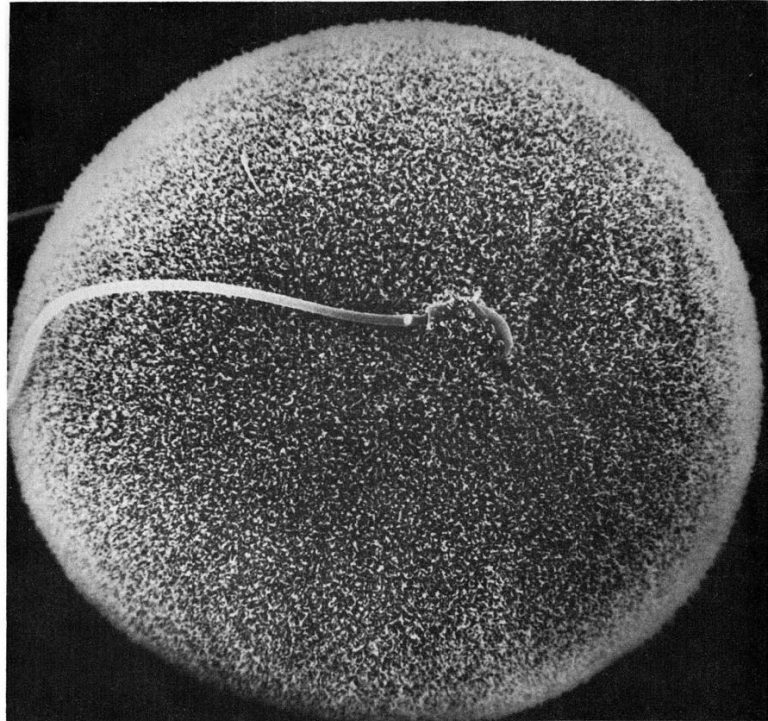
Some individuals only produce one type of sex cell (identified as males or females) while others may produce both sperm and eggs. Those that produce both types are hermaphroditic. Hermaphroditism can be either sequential (they can switch from producing one sex cell to producing another sex cell) or simultaneous (they can produce both sex cells at one time).
External Fertilization
External fertilization usually occurs in aquatic environments where both eggs and sperm are released into the water. After the sperm reaches the egg, fertilization takes place. Most external fertilization happens during the process of spawning where one or several females release their eggs and the male(s) release sperm in the same area, at the same time. The release of the reproductive material may be triggered by water temperature or the length of daylight. Nearly all fish spawn, as do crustaceans (such as crabs and shrimp), mollusks (such as oysters), squid, and echinoderms (such as sea urchins and sea cucumbers). Figure 5a shows salmon spawning in a shallow stream. Frogs, like those shown in Figure 5b, corals, mayflies, and mosquitoes also spawn.
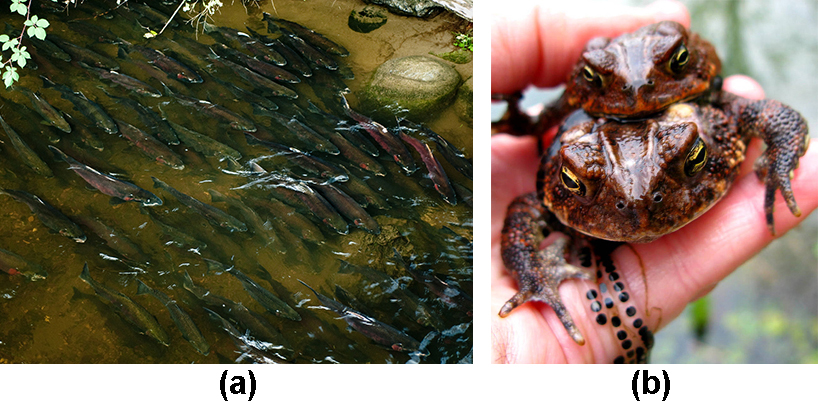
Pairs of fish that are not broadcast spawners may exhibit courtship behavior. This allows the female to select a particular male. The trigger for egg and sperm release (spawning) causes the egg and sperm to be placed in a small area, enhancing the possibility of fertilization.
External fertilization in an aquatic environment protects the eggs from drying out. Broadcast spawning can result in a greater mixture of the genes within a group, leading to higher genetic diversity and a greater chance of species survival in a hostile environment. For sessile aquatic organisms like sponges, broadcast spawning is the only mechanism for fertilization and colonization of new environments. The presence of the fertilized eggs and developing young in the water provides opportunities for predation resulting in a loss of offspring. Therefore, millions of eggs must be produced by individuals, and the offspring produced through this method must mature rapidly. The survival rate of eggs produced through broadcast spawning is low.
Internal Fertilization
Internal fertilization occurs most often in land-based animals, although some aquatic animals also use this method. There are three ways that offspring are produced following internal fertilization. In oviparity, fertilized eggs are laid outside the female’s body and develop there, receiving nourishment from the yolk that is a part of the egg. This occurs in most bony fish, many reptiles, some cartilaginous fish, most amphibians, two mammals, and all birds. Reptiles and insects produce leathery eggs, while birds and turtles produce eggs with high concentrations of calcium carbonate in the shell, making them hard. Chicken eggs are an example of this second type.
In ovoviparity, fertilized eggs are retained in the female, but the embryo obtains its nourishment from the egg’s yolk and the young are fully developed when they are hatched. This occurs in some bony fish (like the guppy Lebistes reticulatus), some sharks, some lizards, some snakes (such as the garter snake Thamnophis sirtalis), some vipers, and some invertebrate animals (like the Madagascar hissing cockroach Gromphadorhina portentosa).
In viviparity the young develop within the female, receiving nourishment from the mother’s blood through a placenta. The offspring develops in the female and is born alive. This occurs in most mammals, some cartilaginous fish, and a few reptiles.
Internal fertilization has the advantage of protecting the fertilized egg from dehydration on land. The embryo is isolated within the female, which limits predation on the young. Internal fertilization enhances the fertilization of eggs by a specific male. Fewer offspring are produced through this method, but their survival rate is higher than that for external fertilization.
Did I Get It?
CC Licensed Content, Shared Previously, Included in Reproduction in Populations
- Chromosomes, Genes, and Traits: An Introduction to Genetics. Author: Amanda Simons. Provided by: Pressbooks. Located at: Chromosomes, Genes, and Traits: An Introduction to Genetics – Simple Book Publishing. License: CC BY-SA 4.0
- An Interactive Introduction to Organismal and Molecular Biology, 2nd ed. Author: Andrea Bierema. Provided by: Pressbooks. Located at: An Interactive Introduction to Organismal and Molecular Biology, 2nd ed. – Simple Book Publishing. License: CC BY-SA 4.0

